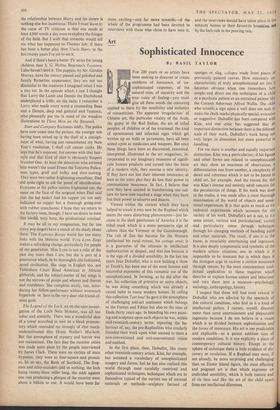Art
Sophisticated Innocence
By BASIL TAYLOR FOR 200 years or so artists have been seeking to discover or create emblems of innocence, of un- sophisticated responses, of the natural man, of sincerity and the true voice of feeling—you must give all these words the colouring applied to them by the sensibility and aesthetics of romanticism. The apparent 'irregularities' of Chinese art, the particular vitality of the Arab, the gypsy or the Red Indian, the art of tribal peoples, of children or of the irrational, the kind of spontaneous and informal signs which get written up on walls or pavements, have, all been seized upon as medicines and weapons. But once these things have been so discovered, examined, ,interpreted, illustrated in the art magazines, in-' corporated in our imaginary museums of signifi- cant human products and turned into the basis of a modern style, they assume a new identity. If they have not lost their inherent innocence, at least as the years pass they do lose their power to communicate innocence. In fact, I believe that now they have assisted in transforming our cul- ture we have now reached a stage when they have lost their power to unnerve and disarm.
Viewed within the context which they have helped to create it may now be the Raphael which seems the more disturbing phenomenon—just be- cause in the sleek penthouses of America it is the tribal mask which is a more persuasive sign of culture than the Vermeer or. the Gainsborough. The cult of Zen has become for the Western intellectual his rural retreat, his cottage orne; it is a guarantee of the ultimate in intellectual sophistication or despair, and that just because it is the sign of a divided sensibility. In the last ten years Jean Dubuffet, who is now holding a show at Tooth's, has been one of the most famous and successful exponents of this romantic use of the unsophisticated. In forming, as he did after the war, his collection of primitive or naive objects, he was doing something which was already a casual habit in many modern homes. In calling this collection Tart brut' he gave it the atmosphere of challenging anti-art sentiment which belongs to the Forties and Fifties but also to the time of Dada thirty years ago. In founding his own paint- ing and sculpture upon such objects he was, within mid-twentieth-century terms, repeating the be- haviour of, say, the pre-Raphaelites who similarly founded their work upon what seemed to them a non-conventional and anti-conventional vision and method.
In the first place, then, Dubuffet, like many other twentieth-century artists, Klee, for example, has assumed a vocabulary of unsophisticated imagery and forms; but he has also realised this world through most carefully contrived and sophisticated techniques, techniques which are in themselves typical of the current use of unusual materials or methods—sculpture formed of sponges or slag, collages 'made from pieces of previously painted canvas. How extremely un- characteristic of truly unsophisticated art this is becomes obvious when one remembers how simple and direct are the techniques of a child or a psychotic patient or an untrained painter like the Cornish fisherman 'Alfred Wallis. The child who scrawls, a sign upon a wall does not seek to make the chalk marks physically special, evocative or suggestive. Dubuffet has been compared with Klee, and one critic has suggested that an important distinction between them is the different scale of their work, Dubuffet's work being not only larger in dimension but more powerful in handling.
For me there is another and equally important distinction. Klee, was a particulariser; if his figures and other forms are related to unsophisticated art they show an exactness of observation, a differentiation one from another, a complexity Of detail and reference which is not to be found in child art, for example. And the reason for this was Klee's intense and entirely adult concern fOr the peculiarities of things. If his work was done in the studio, it was made after a most thorough examination of the world of objects and sensa- tional experiences. It is that quite as much as his technical experiments which accounts for the variety of his work. Dubuffet's art is not, to 11,0 same extent, various and particularised; variety and particularity come through technique, through his changing methods of handling paint and other materials. The result, if one is in the know, is invariably entertaining and ingenious. It is also deeply symptomatic and symbolic of the modern artistic situation, one in which it is impossible to be innocent but in which there is the strongest urge to recover a certain innocence through reason, by the most conscientious intel- lectual application to those inquiries which describe or explain human nature and behaviour and turn them into a museum—psychology, sociology, anthropology, history.
I suspect that those will find most reward in Dubuffet who are affected by the spectacle of this cultural condition, who find in it a kind of intellectual pathos. I cannot, myself, discover more than some entertainment and pleasurable ingenuity because I do not believe in a vision which is so divided between sophistication and the forms of innocence. His art is too predictable and explicable—as a patent addition sum of modern conditions, It is too explicitly a piece of contemporary cultural history. Except in the sphere of technique there is little evidence of dis- covery or revelation. If a Raphael may soon, if not already, be more surprising and challenging than an Easter Island figure, the most affecting and poignant art is that which expresses an undivided sensibility, which is both mature and of its time and like the art of the child apart from our intellectual dilemmas.


































 Previous page
Previous page